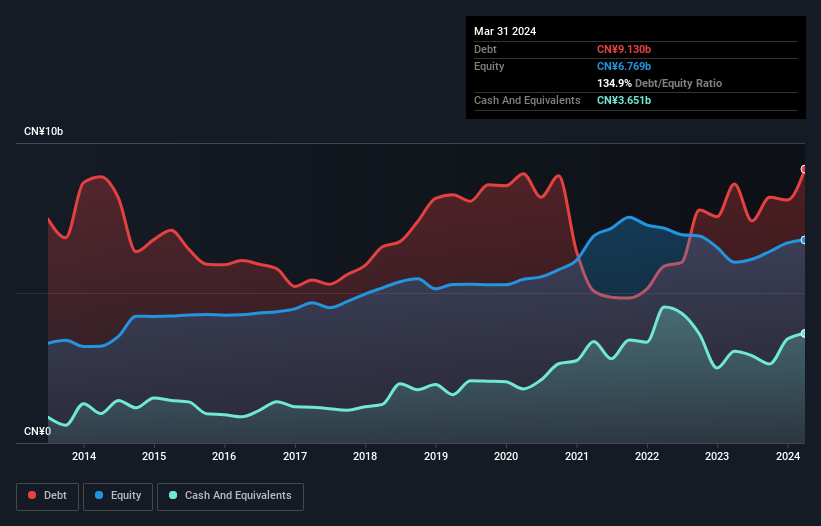- China
- /
- Paper and Forestry Products
- /
- SHSE:600966
Does Shandong Bohui Paper IndustryLtd (SHSE:600966) Have A Healthy Balance Sheet?

Legendary fund manager Li Lu (who Charlie Munger backed) once said, 'The biggest investment risk is not the volatility of prices, but whether you will suffer a permanent loss of capital.' So it might be obvious that you need to consider debt, when you think about how risky any given stock is, because too much debt can sink a company. We can see that Shandong Bohui Paper Industry Co.,Ltd. (SHSE:600966) does use debt in its business. But is this debt a concern to shareholders?
What Risk Does Debt Bring?
Debt assists a business until the business has trouble paying it off, either with new capital or with free cash flow. Part and parcel of capitalism is the process of 'creative destruction' where failed businesses are mercilessly liquidated by their bankers. However, a more common (but still painful) scenario is that it has to raise new equity capital at a low price, thus permanently diluting shareholders. Of course, the upside of debt is that it often represents cheap capital, especially when it replaces dilution in a company with the ability to reinvest at high rates of return. The first thing to do when considering how much debt a business uses is to look at its cash and debt together.
Check out our latest analysis for Shandong Bohui Paper IndustryLtd
What Is Shandong Bohui Paper IndustryLtd's Net Debt?
You can click the graphic below for the historical numbers, but it shows that as of March 2024 Shandong Bohui Paper IndustryLtd had CN¥9.13b of debt, an increase on CN¥8.63b, over one year. However, because it has a cash reserve of CN¥3.65b, its net debt is less, at about CN¥5.48b.

How Healthy Is Shandong Bohui Paper IndustryLtd's Balance Sheet?
Zooming in on the latest balance sheet data, we can see that Shandong Bohui Paper IndustryLtd had liabilities of CN¥13.6b due within 12 months and liabilities of CN¥3.08b due beyond that. Offsetting these obligations, it had cash of CN¥3.65b as well as receivables valued at CN¥1.91b due within 12 months. So its liabilities total CN¥11.1b more than the combination of its cash and short-term receivables.
The deficiency here weighs heavily on the CN¥6.78b company itself, as if a child were struggling under the weight of an enormous back-pack full of books, his sports gear, and a trumpet. So we'd watch its balance sheet closely, without a doubt. After all, Shandong Bohui Paper IndustryLtd would likely require a major re-capitalisation if it had to pay its creditors today.
We use two main ratios to inform us about debt levels relative to earnings. The first is net debt divided by earnings before interest, tax, depreciation, and amortization (EBITDA), while the second is how many times its earnings before interest and tax (EBIT) covers its interest expense (or its interest cover, for short). This way, we consider both the absolute quantum of the debt, as well as the interest rates paid on it.
Shandong Bohui Paper IndustryLtd has a debt to EBITDA ratio of 2.6 and its EBIT covered its interest expense 4.0 times. Taken together this implies that, while we wouldn't want to see debt levels rise, we think it can handle its current leverage. However, the silver lining was that Shandong Bohui Paper IndustryLtd achieved a positive EBIT of CN¥1.4b in the last twelve months, an improvement on the prior year's loss. There's no doubt that we learn most about debt from the balance sheet. But it is future earnings, more than anything, that will determine Shandong Bohui Paper IndustryLtd's ability to maintain a healthy balance sheet going forward. So if you're focused on the future you can check out this free report showing analyst profit forecasts.
Finally, a business needs free cash flow to pay off debt; accounting profits just don't cut it. So it is important to check how much of its earnings before interest and tax (EBIT) converts to actual free cash flow. Over the last year, Shandong Bohui Paper IndustryLtd actually produced more free cash flow than EBIT. That sort of strong cash conversion gets us as excited as the crowd when the beat drops at a Daft Punk concert.
Our View
Mulling over Shandong Bohui Paper IndustryLtd's attempt at staying on top of its total liabilities, we're certainly not enthusiastic. But at least it's pretty decent at converting EBIT to free cash flow; that's encouraging. Looking at the balance sheet and taking into account all these factors, we do believe that debt is making Shandong Bohui Paper IndustryLtd stock a bit risky. That's not necessarily a bad thing, but we'd generally feel more comfortable with less leverage. When analysing debt levels, the balance sheet is the obvious place to start. But ultimately, every company can contain risks that exist outside of the balance sheet. Be aware that Shandong Bohui Paper IndustryLtd is showing 1 warning sign in our investment analysis , you should know about...
If you're interested in investing in businesses that can grow profits without the burden of debt, then check out this free list of growing businesses that have net cash on the balance sheet.
New: Manage All Your Stock Portfolios in One Place
We've created the ultimate portfolio companion for stock investors, and it's free.
• Connect an unlimited number of Portfolios and see your total in one currency
• Be alerted to new Warning Signs or Risks via email or mobile
• Track the Fair Value of your stocks
Have feedback on this article? Concerned about the content? Get in touch with us directly. Alternatively, email editorial-team (at) simplywallst.com.
This article by Simply Wall St is general in nature. We provide commentary based on historical data and analyst forecasts only using an unbiased methodology and our articles are not intended to be financial advice. It does not constitute a recommendation to buy or sell any stock, and does not take account of your objectives, or your financial situation. We aim to bring you long-term focused analysis driven by fundamental data. Note that our analysis may not factor in the latest price-sensitive company announcements or qualitative material. Simply Wall St has no position in any stocks mentioned.
About SHSE:600966
Shandong Bohui Paper IndustryLtd
Researches, develops, produces, sells, imports, and exports paper products in China.
Reasonable growth potential and fair value.
Market Insights
Community Narratives




